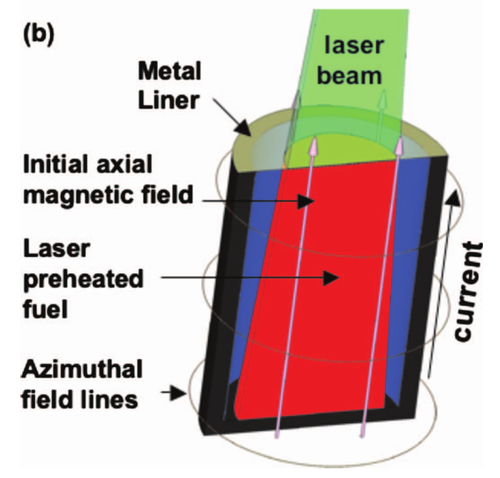In a previous post I discussed the two major approaches to achieving a fusion reaction – either by using strong magnetic fields to prevent hot ions from leaving the reactor, or by using high pressures to crush the plasma until it is hot and dense and fuses very rapidly.
These represent two extremes, and some effort has been put into combining the best features of both. Plasmas do consist of charge particles, which follow magnetic field lines, so using a magnetic field is probably a good idea. But plasmas are very unstable, so trying to get the fusion reaction to happen quickly is also a good idea. The combination of magnetic fields with rapidly imploding plasmas is called Magnetised Target Fusion – the target for the high pressure implosion is a plasma with a magnetic field helping to keep the particles in place.
There are many different ideas for what sort of plasma that target should be, and how the implosion should be driven. One approach is Magnetised Liner Inertial Fusion, or MagLIF, which has been developed extensively by Sandia National Labs in Albuquerque, New Mexico, USA.
Here’s a schematic, from this paper. I’ll describe what’s meant to happen below.

The ‘liner’ here is a hollow metal cylinder. The cylinder is filled with the fusion fuel, a mixture of hydrogen isotopes. There is a strong magnetic field along the axis of the cylinder, around 10 Tesla – about 10 million times stronger than the Earth’s magnetic field. The fuel is first heated slightly by a laser until it becomes a plasma. Now the ions and electrons inside the plasma can only flow along the magnetic field lines, between the top and bottom of the cylinder, and not to the walls of the liner. This is good – if an ion or an electron touches the cold metal walls, it would cool down and make it very hard to achieve fusion. Now a large current – around 70 million Amperes – is passed through the cylinder, from the bottom to the top.
If you’ve ever seen a lightning rod after a lightning strike, you’ll know what happens next:

Photo by Brian James, from Wikipedia. Used under GFDL.
The metal cylinder is crushed by the immense force produced by the current. The fuel inside is compressed, and the magnetic field is compressed with it. The magnetic field stops the ions and electrons hitting the walls as the liner compresses inwards, so instead the ions get extremely hot and dense – perfect conditions for fusion.
In a few millionths of a second, it’s all over. The fuel has mostly fused, releasing a huge amount of energy in the form of fast particles called neutrons. In order to build a power plant using this principle, this cycle of laser heating followed by rapid compression should take place ten times a second – a tall order!
Unsurprisingly, it’s not as simple as it sounds. There are many issues that need to be solved for this technique to work.
Using a laser to heat a gas doesn’t work very well – as opposed to heating it uniformly, the laser tends to heat some small areas more than others, which makes it more difficult to compress the plasma uniformly. I’m investigating whether x-rays might work better than a laser for heating the gas, and I’ll write more on why this might be a good idea in a future post.
When the liner compresses inwards, ripples can develop on the inside and outside surfaces, much like on the lightning rod above. This also hinders a nice uniform compression – remember in the previous post the analogy with squeezing a water balloon in your hands.
Finally, we need a way to extract the energy from the fast neutrons. If the neutrons hit something, they will give up most of their energy as heat, so the problem will then be to convert that heat back into electricity. Nuclear fission reactors currently convert neutron energy to electricity, but the neutrons in fission are far slower than in fusion, so new techniques need to be developed to make MagLIF viable.
Journal articles which discuss this in depth.: